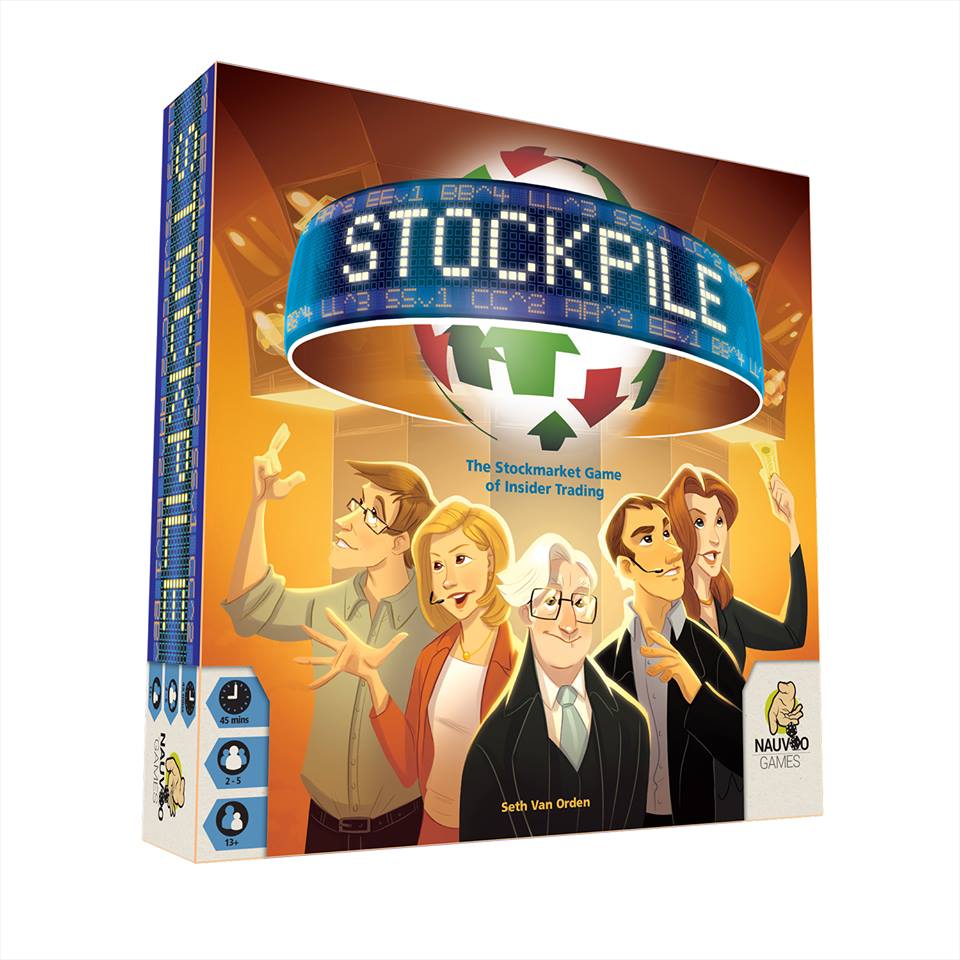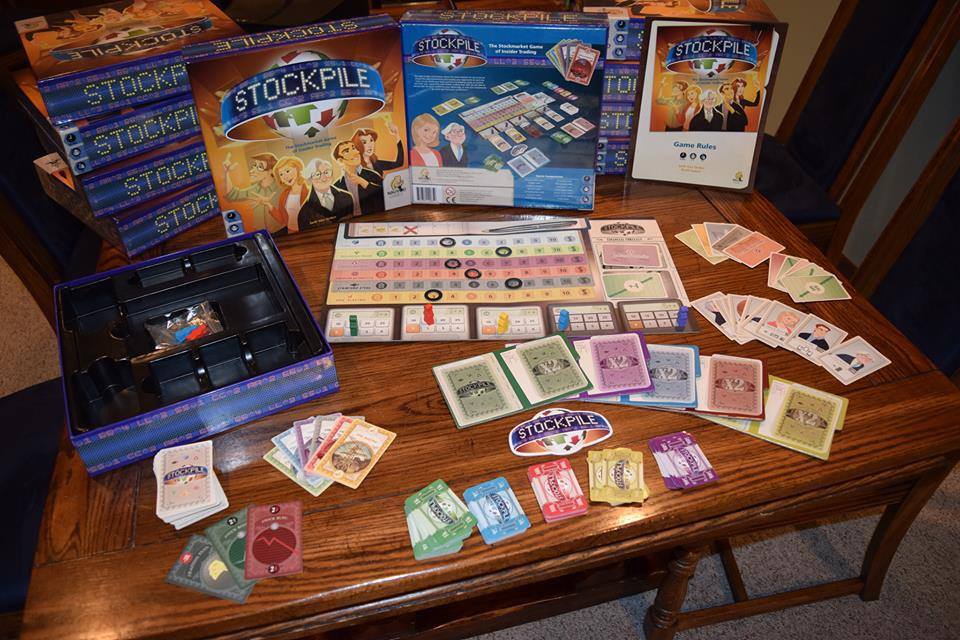I’m not much of a risk taker, to be honest with you. The only time I gamble is when I’m playing with virtual pretend money, giving me the opportunity to lose it all and instantly replenish my funds with the press of a button. It would be awesome if the real world worked that way, wouldn’t it? I’m even less familiar with the stock market, but that’s okay…”Stockpile” doesn’t require you to be a Wall Street guru in order to play it. Let’s take a quick peek at the rules so I can show you what I mean.

Stockpile: 2-5 Players, Ages 13+, Average Play Time = 45 Minutes
Components
The includes 1 main board, 1 turn marker, six stock tickers/tokens, 6 company cards, 6 forecast cards, 5 player boards, 7 bidding meeples, 100 currency cards, 1 first player token, 60 stock cards (10 of each type), 12 trading fee cards, and 8 action cards. The latter three card types form an 80 card market deck.
Setup & Gameplay
Game setup various somewhat depending on whether or not you use some or all of the advanced rules and whether or not you have two players playing the game. As such, I’ll briefly state that each player gets a bidding meeple (two in a two player game), player board, a different stock card from the market deck (which is placed in their portfolio), and some starting money (default is $20,000). There are six company cards and six forecast cards…they’ll be shuffled into separate piles and placed off to the right of the main board. The turn marker and stock tickers go on their appropriate starting spaces. The player who paid the most for their previous meal gets the first player token. There are some advanced rules that you can include, like flipping the board over to the advanced side, using character cards, and etc.
The game is played over a series of rounds (depends on the number of players). Play proceeds clockwise throughout a round and the first player token is passed to the next player (clockwise)when the round is over. Each round has six phases:
1. Information Phase – Each player receives a company Card (listing one of the six companies) and a forecast Card (a plus or minus value), clueing them in as to how one of the six company’s stock price will change during the movement phase. These cards are hidden from the other players. Then, as public information, one company card and one forecast card are drawn face-up. In a two player game, each player receives two pairs of company / forecast cards and the other two remain face-down (no public knowledge).
2. Supply Phase – Firstly, one card is dealt from the deck face-up for each stockpile (underneath the calculators). Each player places receives two cards from the deck, then placing them into stockpiles of their choosing in turn order. One card is placed face-up while the other is placed face-down. In a two player game, both players do this twice. Stockpiles represent the market supply, and they are bid on and obtained during the Demand Phase.
3. Demand Phase – In turn order, players bid with their meeple on the numbered spaces (on the calculator) above each stockpile. If outbid, that player removes their meeple and can bid again on their next turn. Once everyone has bid, everyone pays the bank and receives the stockpile they won. Any stock cards obtained are placed face-down into their portfolio.
4. Action Phase – In turn order, players use all of their action cards (if any) obtained during the demand phase.
5. Selling Phase – In turn order, players may sell any number of stocks that they have obtained by placing them face-up in the discard pile and collecting money from the bank equal to the stock’s current value for each stock. Stocks sold from a player’s split portfolio pay two times the value of the stock.
6. Movement Phase – In turn order, players reveal their company cards and forecast cards and move the stock values accordingly. Move the remaining stock values according to the face-up and face-down pairs of company cards and forecast cards on top of and next to the board. All stocks will be affected every round. The forecast card labeled “$$” means a company pays out dividends. The stock value does not change. Instead, each player immediately receives $2,000 for each share of that company’s stock in his/her portfolio, assuming they choose to reveal that they have it.
If a stock’s value ever increases to more than 10, the stock splits. A stock split effectively doubles your existing shares for that stock (2x pile). The value of that stock returns to 6. If a stock’s value ever moves below 1 on a turn, it immediately goes bankrupt. All players discard all stock of that kind that they own, including any stocks in their split portfolio. Return the stock’s price to the starting value of 5.
Rounds continue until a number of turns have expired. All players reveal the stocks in their portfolios and receive $10,000 if they are the majority shareholder for a particular company (have the most stock cards). Stocks in the 2x pile are worth two cards. Each player then sells their stock cards at the price listed. Players then add up their currency and whoever has the most, wins!
Editor’s Note: The above doesn’t cover all of the rules found in the manual, but should give you an idea as to how the game is played.

The Review
Despite my edition’s crappy components, “Acquire” holds a special place in my collection because of how well it plays and depicts a company’s growth or decline. I felt the same way about “Stockpile”, with the exception of the components bit because they are indeed superb. “Stockpile” does an excellent job of introducing the idea of stock market practices without getting caught up in specific, nitty-gritty details. In other words, it helped me to educate Vinnie Jr. on the basics of how the stock market works. It also works well as a two player game, which surprises me as a lot of stock market themed games generally work better with three or more players.
In addition, the game includes a number of advanced rules or expansions that can be includes should players choose to use them. Character/Investor cards, for example, define a player’s starting money and give them special abilities. In a two player game, each player gets two. There’s also two sides to the main board…the basic side having all companies sharing the same valued tracks. On the advanced flip side, each company’s track is different. There are also dividend spaces that award players $1,000 (double for 2x) for each stock they own of that company.
The insider information part of the game was also pretty interesting. Each player gets private knowledge on one company’s trend at the beginning of every round, so it’ll make you wonder when your opponent decides to bid on or sell stock cards of a certain type. Perhaps they know something you don’t? If your opponent is selling a particular stock like mad, then perhaps they know that the price is about to drop. Of course, they could be bluffing and trying to get you to sell everything you have of that stock so that they can get the majority bonus at the end of the game (by not selling all of that stock).
Stockpile is an excellent game, no ifs, ands, or buts about it. Fans of “Acquire” or other stock market themed games will do well to pick this one up. The price is fairly hefty at about $50 (as of 1/28/16), but if you can afford to pick it up, I recommend doing so.
Final Verdict: 9/10
—
